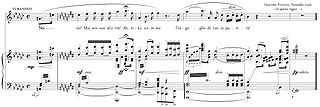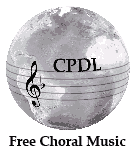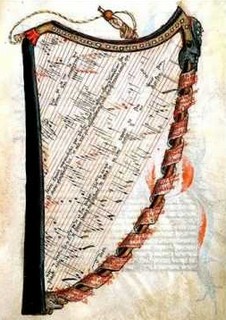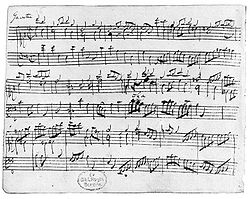
The Cantigas de Santa Maria are 420 poems with musical notation, written in the medieval Galician-Portuguese language during the reign of Alfonso X of Castile El Sabio (1221–1284). Traditionally, they are all attributed to Alfonso, though scholars have since established that the musicians and poets of his court were responsible for most of them, with Alfonso being credited with a few as well.

A manuscript was, traditionally, any document written by hand or typewritten, as opposed to mechanically printed or reproduced in some indirect or automated way. More recently, the term has come to be understood to further include any written, typed, or word-processed copy of an author's work, as distinguished from the rendition as a printed version of the same.

Music notation or musical notation is any system used to visually represent aurally perceived music played with instruments or sung by the human voice through the use of written, printed, or otherwise-produced symbols, including notation for durations of absence of sound such as rests.

Musical composition can refer to an original piece or work of music, either vocal or instrumental, the structure of a musical piece or to the process of creating or writing a new piece of music. People who create new compositions are called composers. Composers of primarily songs are usually called songwriters; with songs, the person who writes lyrics for a song is the lyricist. In many cultures, including Western classical music, the act of composing typically includes the creation of music notation, such as a sheet music "score", which is then performed by the composer or by other musicians. In popular music and traditional music, songwriting may involve the creation of a basic outline of the song, called the lead sheet, which sets out the melody, lyrics and chord progression. In classical music, orchestration is typically done by the composer, but in musical theatre and in pop music, songwriters may hire an arranger to do the orchestration. In some cases, a pop or traditional songwriter may not use written notation at all and instead compose the song in their mind and then play, sing or record it from memory. In jazz and popular music, notable sound recordings by influential performers are given the weight that written or printed scores play in classical music.
In Western musical notation, the staff (US) or stave (UK) also occasionally referred to as a pentagram is a set of five horizontal lines and four spaces that each represent a different musical pitch or in the case of a percussion staff, different percussion instruments. Appropriate music symbols, depending on the intended effect, are placed on the staff according to their corresponding pitch or function. Musical notes are placed by pitch, percussion notes are placed by instrument, and rests and other symbols are placed by convention.
Sheet music is a handwritten or printed form of musical notation that uses musical symbols to indicate the pitches, rhythms, or chords of a song or instrumental musical piece. Like its analogs – printed books or pamphlets in English, Arabic, or other languages – the medium of sheet music typically is paper. However, access to musical notation since the 1980s has included the presentation of musical notation on computer screens and the development of scorewriter computer programs that can notate a song or piece electronically, and, in some cases, "play back" the notated music using a synthesizer or virtual instruments.

LilyPond is a computer program and file format for music engraving. One of LilyPond's major goals is to produce scores that are engraved with traditional layout rules, reflecting the era when scores were engraved by hand.
In musical notation, a bar is a segment of music bounded by vertical lines, known as bar lines, usually indicating one of more recurring beats. The length of the bar, measured by the number of note values it contains, is normally indicated by the time signature.
A scorewriter, or music notation program is software for creating, editing and printing sheet music. A scorewriter is to music notation what a word processor is to text, in that they typically provide flexible editing and automatic layout, and produce high-quality printed results.

Braille music is a braille code that allows music to be notated using braille cells so music can be read by visually impaired musicians. The system was incepted by Louis Braille.

Music engraving is the art of drawing music notation at high quality for the purpose of mechanical reproduction. The term music copying is almost equivalent—though music engraving implies a higher degree of skill and quality, usually for publication. The name of the process originates in plate engraving, a widely used technique dating from the late sixteenth century. The term engraving is now used to refer to any high-quality method of drawing music notation, particularly on a computer or by hand.
capella is a musical notation program or scorewriter developed by the German company Capella Software AG, running on Microsoft Windows or corresponding emulators in other operating systems, like Wine on Linux and others on Apple Macintosh. Capella requires to be activated after a trial period of 30 days. The publisher writes the name in lower case letters only. The program was initially created by Hartmut Ring, and is now maintained and developed by Bernd Jungmann.
NoteWorthy Composer (NWC) is a proprietary scorewriter application made by NoteWorthy Software. It is a graphical score editor for Microsoft Windows computers. Version 1 of NWC was released in October 1994, and Version 2 in September 2008.

A vocal score or piano–vocal score is a music score of an opera, or a vocal or choral composition written for orchestral accompaniment, such as an oratorio or cantata. In a piano–vocal score, the vocal parts are written out in full, but the accompaniment is reduced and adapted for keyboard. The music is usually reduced to two staves; however, more staves, a second keyboardist, or a second keyboard part can be added, as needed.

The Choral Public Domain Library (CPDL) is a sheet music archive which focuses on choral and vocal music in the public domain or otherwise freely available for printing and performing.

La Harpe de Melodie is a musical composition by Jacob Senleches in the ars subtilior style.
Manuscript paper is paper preprinted with staves ready for musical notation. A manuscript is made up of lines and spaces, and these lines and space have their names depending on the staves. Manuscript paper is also available for drum notation and guitar tabulature.

Mozart the music processor is a proprietary WYSIWYG scorewriter program for Microsoft Windows. It is used to create and edit Western musical notation to create and print sheet music, and to play it via MIDI.
MusicEase is a proprietary WYSIWYG scorewriter created by Gary Rader and produced by MusicEase Software. It enables computers using Microsoft Windows and MacOS to produce musical notation and listen to them in MIDI.
Modified Stave Notation (MSN) is an alternative way of notating music that was developed in the UK where it is widely used. MSN is intended to be used by people who cannot easily read ordinary musical stave notation (or staff notation), even if it is enlarged, or for some people reduced in size. Such users include those with visual impairments and those who are dyslexic.











